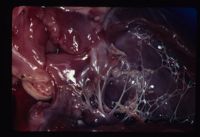Degenerative Mitral Valve Disease
| This article is still under construction. |
Also known as MVD
- Common in dogs and cats
- Rare in other species
Signalment
Genetics & Predisposed Breeds: Large Breeds (e.g., Bull Terrier, Miniature Bull Terrier, English Bulldog, Great Dane, German Shepherd, Newfoundland, Irish Setter)
Description
- Congenital malformation of the mitral valve and its supporting structures (chordae tendineae, papillary muscles, valvular leaflets, annulus) results in mitral stenosis (narrowing) or regurgitation (insufficiency)
- Mitral Stenosis: left ventricle is not able to fill completely during diastole; Increase in left atrial pressures
- Mitral Regurgitation (Insufficiency): leaky mitral valve allows blood to flow back into atria causing increased left atrial pressure and increased pressure in the pulmonary veins
Diagnosis
History & Clinical Signs
Mild defects may be asymptomatic
Signs of left sided congestive (dilated) heart failure:
-Cough
-Tachypnea/Dyspnea
-Exercise Intolerance
-Syncope
-Pale Mucous Membranes
-Tachycardia
-Arrhythmias
Physical Exam
-Left apical systolic murmur
-Left diastolic murmur
-Poor pulses
Radiographic Findings
-Left atrial enlargement
-Left ventricular enlargement
-Enlargement of pulmonary veins
-Pulmonary edema
Echocardiographic Findings
-Left atrial enlargement
-Left ventricular enlargement
-Malformed valve leaflets
Doppler can detect mitral stenosis or regurgitation and estimate pressures in the left atrium and pulmonary veins
Electrocardiographic (ECG)
-May be normal
-Signs of left atrial (wide P waves)
-Signs of left ventricular (tall R waves)
-Signs of arrhythmias
Treatment
Control left atrial pressure and manage left sided congestive heart failure
Goal of treatment for congestive heart failure:
-Diuretics (decrease venous congestion)
-ACE-inhibitors; Vasodilators (inhibit water retention and dilate the vessels)
-Anti-coagulants (cats) to prevent thrombus formation
Prognosis
Mild Defects
-Excellent
Severe Defects
-Guarded
From Pathology
Often associated with mitral regurgitation and left atrial volume overload. Usually progresses to left sided heart failure.
Incidence:
- Most common congenital defect in cats.
- Also reported in pure breed dogs E.g GSD, Great Danes.
Clinical Signs:
- Often murmur is the only clinical sign; pansystolic with increased intensity over the mitral valve area.
- May also see exercise intolerance, dyspnoea and coughing.
Diagnosis:
- Left atrial enlargement on radiology and ECG.
- Doppler echocardiography can dtect abnormal flow.
Treatment:
- Prognosis poor, medically manage left heart failure with ACE-inhibitors etc.

